
The Cheirogaleidae are the family of strepsirrhine primates containing the various dwarf and mouse lemurs. Like all other lemurs, cheirogaleids live exclusively on the island of Madagascar.
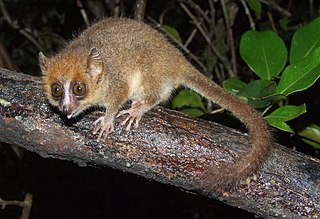
The pygmy mouse lemur, also known as Peters' mouse lemur or dormouse lemur, is a primate weighing only 43–55 g (1.5–1.9 oz); it is the second smallest of the mouse lemurs. Its dorsal side is a rufous-brown colour, and creamy-white ventrally. It lives in dry deciduous forests of western Madagascar. It has been captured in the Tsingy de Bemaraha Nature Reserve, the Andramasy forests north of Belo sur Tsiribihina, and the border of heavily degraded deciduous forest and savanna at Aboalimena. It has also been found in other habitats, in mangroves in two localities.

The Sambirano mouse lemur is a small, recently discovered primate and like the other mouse lemurs can only be found on the island of Madagascar. The dorsal side is both cinnamon and rufous-cinnamon and is grey ventrally. It has vibrissae that are dark in color.
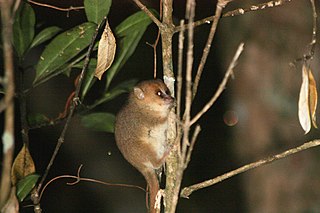
Goodman's mouse lemur is a species of mouse lemur from the region near Andasibe in eastern Madagascar. The species is named in honor of primatologist Steven M. Goodman. "Lehilahytsara" is a combination of the Malagasy words which mean "good" and "man". The finding was presented August 10, 2005, along with the discovery of the northern giant mouse lemur as a separate species.

Jolly's mouse lemur is a species of mouse lemur from Mananjary and Kianjavato in Madagascar. The species is named in honor of primatologist Alison Jolly.
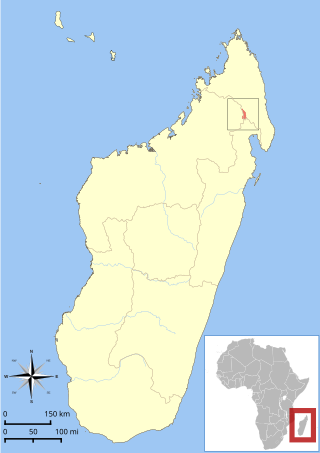
Mittermeier's mouse lemur is a species of mouse lemur known only from Anjanaharibe-Sud Special Reserve in Madagascar.
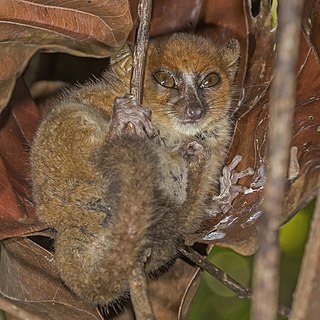
Claire's mouse lemur, or the Nosy Be mouse lemur, is a newly described species of lemur from the genus of the mouse lemurs (Microcebus). It lives on the island Nosy Bé in the Antsiranana province of Madagascar, and on the mainland near the village of Manehoka, including Lokobe Reserve. The scientific type name, mamiratra, comes from Malagasy and means "clear and bright"; this refers the Theodore F. and Claire M. Hubbard Family Foundation, which has contributed to genetic research on Madagascar. This species is closely related to another new species, "M. species nova # 5"; which is related to the Sambirano mouse lemur, Microcebus sambiranensis, and the northern rufous mouse lemur, Microcebus tavaratra.

The northern rufous mouse lemur, northern brown mouse lemur, or Tavaratra mouse lemur is found in northern Madagascar from the Ankarana Special Reserve in the west to the Manambato River in the northeast, and up to the Irodo River in the north of the Analamerana Special Reserve. The complete distribution range of M. tavaratra is still to be defined as some areas surrounding the described distribution have not been visited yet. For example, M. tavaratra has been reported to possibly occur from the Irodo up to the Montagne des Français. Its known distribution cover four protected areas – the Ankarana Special Reserve, and the Analamerana Special Reserve both managed by Madagascar National Parks, the Loky-Manambato protected area (Daraina), and the Andavakoeira-Andrafiamena protected area, both Managed by the NGO Fanamby

The reddish-gray mouse lemur also known as the gray-brown mouse lemur or rufous-gray mouse lemur, is a small, solitary-but-social, nocturnal and omnivorous primate from the Western Madagascar in the region around Beza Mahafaly Reserve, north to Lamboharana. Like the other lemur species, the reddish-grey mouse lemur is endemic to Madagascar. They generally live in the drier regions of the island. It is categorized as least concerned in the IUCN Red List.

Madame Berthe's mouse lemur or Berthe's mouse lemur is the smallest of the mouse lemurs and the smallest primate in the world; the average body length is 9.2 cm (3.6 in) and seasonal weight is around 30 g (1.1 oz). Microcebus berthae is one of many species of Malagasy lemurs that came about through extensive speciation, caused by unknown environmental mechanisms and conditions.

The mouse lemurs are nocturnal lemurs of the genus Microcebus. Like all lemurs, mouse lemurs are native to Madagascar.

Danfoss's mouse lemur, or the Ambarijeby mouse lemur, is a species of mouse lemur endemic to Madagascar. It lives in western deciduous forest within a limited range between the Sofia River and the Maevarano River. This species has been found in substantial populations in the Ambarijevy, Anjajavy, and Beanamaolo forests in Madagascar. Their lifespan is about 5 years but can live up to 10 years. They are part of the infraorder called lemuriformes which represents 20% of the entire primates diversity and over 60% of the mammalian genera of Madagascar.

Ramanantsoavana's woolly lemur, also known as Ramanantsoavana's avahi or the Manombo woolly lemur, is a species of woolly lemur native to southeastern Madagascar. It weighs about 1 kg. It was originally considered a subspecies of the southern woolly lemur, A. m. ramanantsoavana, but was elevated to a separate species in 2006 based on molecular, phenotypic and morphological data.

MacArthur's mouse lemur, or the Anjiahely mouse lemur, is a species of mouse lemur known only from Makira Natural Park in northeastern Madagascar.
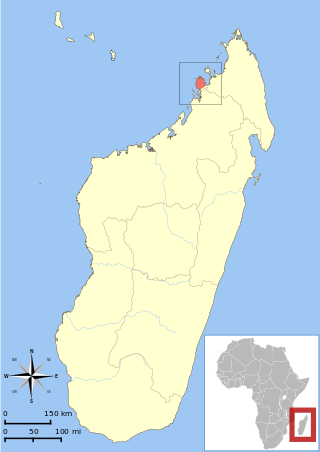
Mittermeier's sportive lemur is a sportive lemur endemic to the Ampasindava Peninsula in Madagascar.

The Bongolava mouse lemur is a species of mouse lemur endemic to Madagascar. It lives in western deciduous forest within a limited range, including Bongolava Forest and Ambodimahabibo Forest between the Sofia River and the Mahajamba River.
The Anosy mouse lemur is a species of mouse lemur known only from the Manantantely Forest and Ivorona Forest in southeastern Madagascar, near Tôlanaro. Specimens were first collected in April 2007, and its discovery was announced in 2013 along with the Marohita mouse lemur. It is a relatively large mouse lemur and lives in the same region as the gray mouse lemur (M. murinus) and the reddish-gray mouse lemur (M. griseorufus), all three of which are found within 10 km (6.2 mi) of each other and are nearly identical in appearance. It has dark brownish fur on its back and light-colored fur on its underside. Nothing is known about its behavior. Its conservation status has not been evaluated by the International Union for Conservation of Nature (IUCN), although its known habitat has degraded since 2007.

The Marohita mouse lemur is a species of mouse lemur known only from the Marohita Forest in eastern Madagascar, near the village of Marolambo. Specimens were first collected in December 2003, and its discovery was announced in 2013 along with the Anosy mouse lemur. It is a large mouse lemur, weighing up to 89 g (3.1 oz), and lives within the same area as the Goodman's mouse lemur (M. lehilahytsara), Simmons' mouse lemur (M. simmonsi), and the brown mouse lemur (M. rufus), all four of which are nearly identical in appearance. Its fur is rufous on its back and grayish-beige on its underside. Nothing is known about its behavior. Its conservation status was evaluated as Endangered by the International Union for Conservation of Nature (IUCN) in 2012, before it was formally described, because its only known habitat had severely degraded between 2003 and 2012.

















